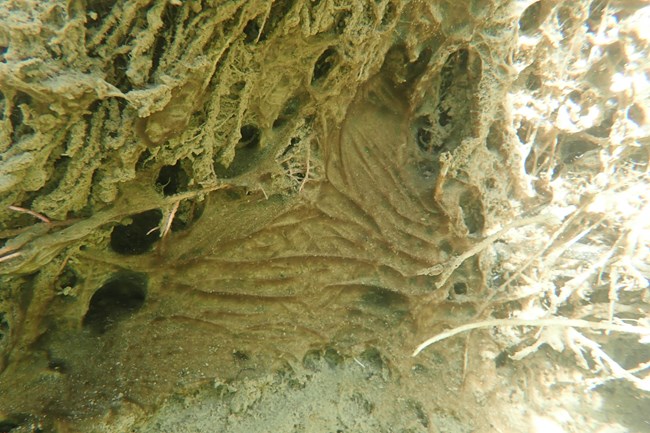
NPS Zion National Park is monitoring for the presence of toxic cyanobacteria and cyanotoxins in water throughout the park. We share information so you can make informed decisions about whether and how to recreate. We work with the Utah Department of Environmental Quality to share recreational advisory levels for still and flowing water throughout the park. Recreational advisory levels are:
Learn more about how the Utah Department of Environmental Quality sets these levels. The National Park Service shares current recreational advisory levels for Zion on this page. Need to know:Do not drink stream water anywhere in the park. Carry water or filter directly from a spring
This table shows the current recreational advisory level for each monitored waterbody in the park. During Health Watch and Warning advisory levels we recommend against swimming or submerging your head in the water. During Danger advisory levels recreators should consider avoiding all contact with the water. Frequently asked questionsIf you may have been exposed to toxin-producing cyanobacteria and have any unexplained symptoms, seek immediate medical attention and contact the Utah Poison Control Center by calling (800) 222-1222. If you are experiencing a medical emergency call 911. No. There are no known recreational filtration or disinfection method that can remove cyanotoxins from the water so that it is safe for drinking. If you must filter water for drinking while in the Wilderness areas of the park, do so directly from a spring source. Symptoms in a humans can include, but are not limited to, irritation in the ears, eyes, nose, skin, or throat. You could also experience a headache, burning, tingling, numbness, pain, incoherent speech, seizures, vomiting and/or diarrhea. Scientist’s understanding of benthic cyanobacteria is evolving. Our understanding of benthic cyanobacteria and the risk it poses to human health are changing with new information. The park uses the best available science and considers the most vulnerable populations (Children and pets) when it sets recreational advisories. The risks are unknown. Check recreational advisory levels to make informed choices about recreation in Zion. Toxin-producing cyanobacteria naturally live in waterbodies throughout the world and in Zion, however, during extended periods of time without flood events toxin-producing cyanobacteria tend to grow in proliferation. When cyanobacteria have the opportunity to grow in large amounts the risk of harm to humans and domestic animals increases. 
NPS More About CyanobacteriaAn introductionCyanobacteria also known as “blue green algae”, are photosynthetic bacteria found in lakes, reservoirs, rivers, streams, and other bodies of water in many places throughout the world. In other waterbodies, cyanobacteria are found on the top of the water or dispersed throughout the water column. In Zion, scientists have found cyanobacteria at the bottom of the Virgin River and its tributaries within the park. The kind of cyanobacteria attached to the bottom of the river is known as benthic cyanobacteria. Benthic cyanobacteria grows on rocks, plants, at the sides of the river and along the river's edge Why are cyanobacteria harmful?Cyanobacteria are naturally occurring but can harm humans or animals because some produce toxins called cyanotoxins. Scientists have found anatoxin-a, microcystin, nodularin and cylindrospermopsin in the park. What to do if you are exposed to cyanobacteriaIf you are exposed to cyanobacteria, seek immediate medical attention and contact the Utah Poison Control Center at (800) 222-1222. If you are experiencing a medical emergency, call 911. 
NPS 
ZION NPS Recognizing cyanobacteriaCyanobacteria grow in different colors and textures. In Zion, these colors include yellow, tan, green, brown, and black and can appear to be round, ribbed, or mucous-like. 
NPS 
NPS 
NPS 
NPS 
NPS Where do cyanobacteria grow?Cyanobacteria are photosynthetic and can grow in water anywhere sunlight can reach them. Benthic cyanobacteria can grow at the bottom of still and flowing water and can also grow attached to plants, rocks, and at the sides or edges of the river. Benthic cyanoabcteria often appear to form in mats but not always. 
NPS 
NPS How is Zion Monitoring for cyanobacteria?Park scientists monitor popular bodies of water for toxin-producing cyanobacteria and cyanotoxins. All data is shared with the Utah Department of Environmental Quality. Monthly monitoring data inform the recreational advisory level. Recreational advisory levels can be found on the park's website, at all visitor contract stations, and on signs posted at major trailheads. Monitoring TechniquesScientists perform visual inspections of selected sites in three major tributaries to the Virgin River in Zion National Park to determine if cyanobacteria are visually present. Additionally, we monitor if there are cyanotoxins within the water column, using a passive monitoring technique called SPATT samples (Solid Phase Adsorption Toxin Tracking). These samples are specially designed to monitor for the presence of toxins in the water column over a period of time. Lastly, if toxin-producing cyanobacteria mat are present, staff will perform a sampling technique called Benthic Disturbance. In Benthic Disturbance samples, staff walk through cyanobacteria mats replicating conditions expected when these mats are disturbed through normal recreational activities. Samples are then taken of the disturbed water and analyzed for their concentration of cyanotoxins. 
NPS Check out our videos series below to learn more!
Learn more about toxic cyanobacteria from:
Visit our keyboard shortcuts docs for details
The first in a series of three videos with information you need before recreating in still or moving water at Zion National Park.
Visit our keyboard shortcuts docs for details
Information about the cyanobacteria in the flowing and still water of Zion National Park and the types of cyanotoxins they produce that can be potentially harmful.
Visit our keyboard shortcuts docs for details
Information on how scientist in Zion study and monitor cyanobacteria and cyanotoxins the Park's still and flowing water. |
An official website of the United States government
Here's how you know
Official websites use .gov
A
.gov website belongs to an official government
organization in the United States.
Secure .gov websites use HTTPS
A
lock (
) or https:// means you've safely connected to
the .gov website. Share sensitive information only on official,
secure websites.
